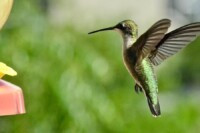Have you ever observed a bird in flight and wondered if they could move in reverse? It might seem like a curious impossibility, but prepare to be amazed! While not a common avian skill, flying backwards is indeed a reality for a select group of birds. However, it’s not a widespread phenomenon across all bird species. In fact, true backward flight, sustained and controlled, is a remarkable ability primarily mastered by just one extraordinary family of birds.
Hummingbirds: The Avian Masters of Backward Flight

If you’re searching for birds that can fly backwards, the answer is a resounding yes – hummingbirds! They are the only bird family capable of genuine, sustained backward flight. This incredible maneuverability isn’t just limited to going backwards; hummingbirds can also fly upside down and even hover motionless in mid-air. This aerial acrobatics is all thanks to their unique wing structure.
Hummingbirds possess a specialized ball and socket joint, akin to our shoulder’s rotator cuff, which provides an exceptional range of motion. This unique joint allows their wings to rotate almost 180 degrees, enabling them to move in a figure-of-eight pattern. This figure-eight wing motion is key to their hovering ability, and crucially, it’s also what empowers them to fly backwards with precision and control. Unlike most other birds whose wing anatomy and musculature are designed solely for forward propulsion, hummingbirds have evolved a system that defies typical avian flight mechanics.
Witnessing a hummingbird in flight is like watching a tiny, feathered helicopter. Their ability to fly backwards is not just a fleeting flutter; it’s a controlled and deliberate movement, often showcased when they navigate intricate floral landscapes. You might have thought you’ve seen other birds flying backwards, but what you likely observed was the wind pushing them back or a brief, unstable backward flutter used defensively. Birds like warblers, egrets, and herons might momentarily fly backwards to evade predators or rivals, but their wing structure doesn’t allow for sustained reverse flight.
The Evolutionary Advantage of Backward Flight for Hummingbirds

For hummingbirds, flying backwards isn’t just an impressive trick; it’s a vital necessity for their survival. While they supplement their diet with berries and insects like ants, aphids, and beetles, hummingbirds primarily rely on nectar for sustenance. Nectar, a sugary liquid produced by flowers, provides the high energy fuel required to support their incredibly fast metabolism and also serves as their primary source of hydration.
Their ability to fly backwards, sideways, and hover with such agility allows them to efficiently access nectar from flowers. They can precisely position themselves at a flower, extract nectar, and then retreat backwards to move to the next blossom without wasting energy or time. This exceptional maneuverability makes nectar feeding far more efficient than it would be if they were limited to forward flight like most other birds. This efficient foraging strategy is crucial for meeting their high energy demands and maintaining their active lifestyle.
Hummingbirds Around the World and Mistaken Identities

Unfortunately for bird enthusiasts in the UK, hummingbirds are not found in the wild there. They are native to the Americas, inhabiting a diverse range of environments from mountains and woodlands to rainforests and deserts, and even adapting to urban settings. Their presence is largely dictated by the availability of flowering plants, their primary food source. While hummingbirds are not UK natives and are challenging to keep in captivity, a few zoos in Britain house these dazzling birds.
Each year, there are often reported “hummingbird sightings” in the UK, but these are invariably cases of mistaken identity. The usual culprit behind these misidentifications is the Hummingbird hawk-moth. This fascinating moth bears a striking resemblance to hummingbirds, often leading to confusion among casual observers.
Even without hummingbirds, the UK boasts a rich variety of unique bird species that can be found in gardens. To enhance the biodiversity of your outdoor space, consider learning how to attract garden birds by providing food, shelter, and protection from predators.
Sources
[i] https://www.thespruce.com/what-do-hummingbirds-eat-386568
[ii] https://en.wikipedia.org/wiki/Hummingbird
[iii] https://www.rspb.org.uk/birds-and-wildlife/wildlife-guides/birdwatching/how-to-identify-birds/hummingbirds-and-hawkmoths/
Gemma Sharp